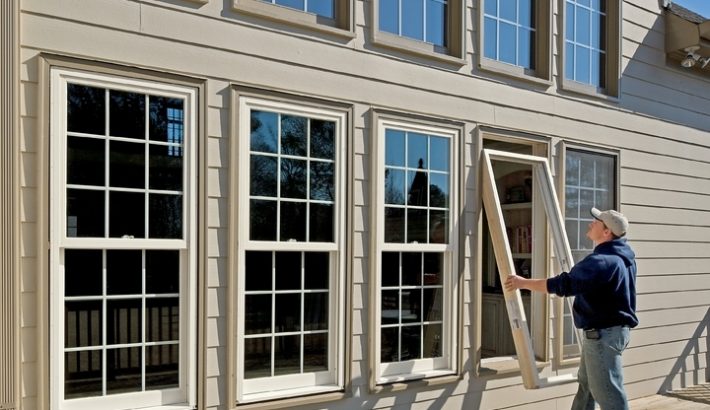Energy-efficient windows are becoming essential in modern building design, driven by the need for sustainable living and energy conservation. These windows are designed to prevent heated or cooled air from escaping your home, reducing the energy required for heating and cooling.
This not only lowers utility bills but also minimizes a household’s carbon footprint. As energy cost rises and the environmental impact of energy consumption becomes more apparent, adopting energy-efficient windows is not just a trend but a necessary step toward a sustainable future.
The Rising Importance of Energy-Efficient Windows in Sustainable Building Design
- How Energy-Efficient Windows Work
Energy-efficient windows, as suggested by Maverick Windows, are constructed with advanced materials and technologies that enhance their insulating properties. One of the primary components is the low-emissivity (Low-E) coating. This microscopically thin, transparent coating reflects infrared energy (heat), allowing visible light to pass through. Low-E glass helps retain heat inside the home during winter, while in summer, it reflects heat away, keeping interiors cooler.
Another crucial element is the use of multiple panes of glass, typically double or triple glazing. The space between the panes is often filled with inert gases like argon or krypton, which are better insulators than air. These features work together to significantly reduce heat transfer, improving the thermal efficiency of the windows.

- The Benefits of Energy-Efficient Windows
The benefits of energy-efficient windows extend beyond just energy savings. Firstly, they lead to significant cost savings on energy bills. Homes with energy-efficient windows can save hundreds of dollars annually on heating and cooling costs. Secondly, they enhance indoor comfort. By reducing drafts and maintaining a consistent indoor temperature, these windows eliminate cold spots and overheating near windows.
Additionally, energy-efficient windows contribute to noise reduction. The features that improve thermal insulation also help dampen external noise, creating a quieter indoor environment. Furthermore, they protect furnishings from UV damage. Low-E coatings block many ultraviolet rays, which can fade and deteriorate furniture, carpets, and artwork.
- Types of Energy-Efficient Windows
Energy-efficient windows come in various types, each with specific features and benefits. Double-glazed windows are the most common, featuring two panes of glass with an insulating gas layer in between. Triple-glazed windows, with three panes, offer even better insulation and noise reduction, making them ideal for colder climates or noisy urban areas.
Another type is the gas-filled window, where the space between the panes is filled with argon or krypton gas, enhancing thermal performance. Low-E windows, with their special coatings, are another popular option. Additionally, some windows feature warm-edge spacers made of insulating materials to reduce heat transfer at the edges. Each window type can be tailored to specific needs and climates, providing optimal energy efficiency.
- Installation and Replacement Considerations
Proper installation is crucial for maximizing the benefits of energy-efficient windows. A correct installation can lead to air leaks and reduced efficiency. Hiring experienced professionals who understand the specific requirements of energy-efficient windows is essential. When replacing old windows, homeowners should consider the framing material as well.
Materials like vinyl, wood, and fibreglass offer different insulation levels and durability. The glazing, frame, and installation method should be tailored to the specific climate and the home’s design. Additionally, ensuring proper sealing around the window is essential to prevent air leaks. A well-installed energy-efficient window will seamlessly integrate with the home’s insulation system, providing optimal performance.
- Financial Incentives and Rebates
The initial cost of energy-efficient windows can concern homeowners, but various financial incentives and rebates are available to offset these expenses. Many governments and local utilities offer rebates for installing energy-efficient windows as part of broader energy-saving programs. Additionally, federal tax credits may be available, allowing homeowners to deduct some of the installation cost from their taxes.
Some programs also provide low-interest loans to help finance the upgrades. These incentives can significantly reduce the upfront cost and make the investment more affordable. By taking advantage of these financial aids, homeowners can quickly recoup their investment through energy savings and enjoy the long-term benefits of reduced utility bills.

- Environmental Impact of Energy-Efficient Windows
The environmental benefits of energy-efficient windows are substantial. By reducing the amount of energy needed to heat and cool a home, these windows help lower greenhouse gas emissions. Energy-efficient windows contribute to a smaller carbon footprint, making them an essential component in the fight against climate change.
Additionally, producing energy-efficient windows has become more sustainable, with many manufacturers adopting eco-friendly practices and materials. For instance, some use recycled glass and sustainable frame materials. By choosing energy-efficient windows, homeowners save on energy costs and support a more sustainable and environmentally friendly industry.
- Technological Advancements in Window Design
Technological advancements continue to improve the performance and functionality of energy-efficient windows. Bright windows, for example, can adjust their tint based on the amount of sunlight, further enhancing energy efficiency and comfort. These windows can be controlled manually or programmed to change automatically, providing optimal light and heat regulation throughout the day.
Additionally, advancements in materials science have led to the development of even more effective insulating materials and coatings. Research into nanotechnology and phase-change materials holds the promise of windows that can dynamically adapt to environmental conditions, offering unprecedented energy efficiency. As technology progresses, energy-efficient windows will become even more effective and accessible.
Energy-efficient windows represent a vital investment for homeowners and builders looking to enhance energy savings, improve indoor comfort, and contribute to environmental sustainability. With advancements in technology and materials, these windows offer superior insulation and performance, significantly reducing heating and cooling costs. The benefits extend beyond energy savings to include noise reduction, protection against UV damage, and increased property value.
Despite the higher initial cost, financial incentives and long-term savings make energy-efficient windows a cost-effective choice. As awareness and technology continue to advance, adopting energy-efficient windows will play a crucial role in creating more sustainable and energy-efficient homes and buildings.

